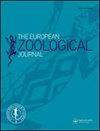Raccoon dog (Nyctereutes procyonoides) phylogeography including the Polish population: local and global aspects
IF 1.4
4区 生物学
Q2 ZOOLOGY
引用次数: 1
Abstract
Abstract The raccoon dog (Nyctereutes procyonoides) is a representative of Canidae and is closely related to red fox-like canids, although the species exhibits high distinctiveness in the family. These animals were farmed for fur products, but thousands were intentionally released into the wild in western Russia. This newly established alien species in Europe has spread rapidly into many European countries. The aim of the study was to determine the origin of Polish populations by comparing the mitochondrial molecular marker cytochrome b (cytb) sequences of Polish wild and farm individuals with wild raccoon dogs from the western Russia and Asian specimens whose sequences were obtained from GenBank resources. The results of our phylogenetic analysis support the previous suggestions on the existence of two main clades clearly referring to continental and Island populations. Polish individuals were classified into a highly diverse continental group. The relationships between the haplotypes within the clade together with estimated values of genetic diversity parameters indicate that the Polish raccoon dog populations exhibit high genetic similarity to the Russian population. In combination with the history of introduction of the species to Europe, this suggests the most probable assignment of the Polish populations to the subspecies N. procyonoides ussuriensis. Our results indicate the presence of two Japanese haplotypes within the continental group, which is inconsistent with the assumed scenario of post-glacial expansion of raccoon dogs excluding gene flow between continental and Island populations.貉(Nyctereutes procyonoides)包括波兰种群的系统地理学:地方和全球方面
摘要:貉(Nyctereutes procyonoides)是犬科动物的代表,与类红狐的犬科动物有密切的亲缘关系,但在科中表现出高度的独特性。这些动物被用来制作毛皮,但在俄罗斯西部,成千上万的动物被故意放归野外。这种在欧洲新建立的外来物种已迅速蔓延到许多欧洲国家。本研究的目的是通过比较波兰野生和农场个体的线粒体分子标记细胞色素b (cytb)序列与来自俄罗斯西部和亚洲标本的野生貉(其序列来自GenBank资源),确定波兰种群的起源。我们的系统发育分析结果支持了先前关于存在两个主要分支的建议,这两个分支明显是指大陆种群和岛屿种群。波兰人被归入一个高度多样化的大陆群体。单倍型之间的关系以及遗传多样性参数的估计值表明,波兰貉种群与俄罗斯貉种群具有较高的遗传相似性。结合该物种引入欧洲的历史,这表明波兰种群最可能属于乌苏利亚种N. procyonoides ussuriensis。我们的研究结果表明,在大陆种群中存在两种日本单倍型,这与假设的冰川后浣熊扩张的情况不一致,排除了大陆种群和岛屿种群之间的基因流动。
本文章由计算机程序翻译,如有差异,请以英文原文为准。
求助全文
约1分钟内获得全文
求助全文
来源期刊

European Zoological Journal
Agricultural and Biological Sciences-Animal Science and Zoology
CiteScore
3.10
自引率
5.60%
发文量
80
审稿时长
30 weeks
期刊介绍:
The European Zoological Journal (previously Italian Journal of Zoology) is an open access journal devoted to the study of all aspects of basic, comparative and applied protozoan and animal biology at molecular, cellular, tissue, organ, organismal, population, and community-ecosystem level. Papers covering multiple levels of organization and integrative approaches to study animal form, function, development, ecology, evolution and systematics are welcome. First established in 1930 under the name of Il Bollettino di Zoologia, the journal now has an international focus, reflected through its global editorial board, and wide author and readership.
 求助内容:
求助内容: 应助结果提醒方式:
应助结果提醒方式:


